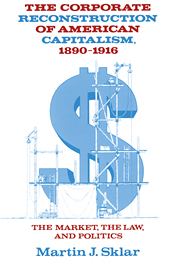Book contents
2 - Metamorphosis in property and thought
Published online by Cambridge University Press: 06 July 2010
Summary
Introduction
The crisis of the 1890s in the United States centered upon a breakdown of production and exchange relations that telescoped a cyclical depression within a secular decomposition of the competitive market regime. The cyclical and secular trends together yielded a combined economic crisis – the last great depression of competitive capitalism. The disruption of goods and capital markets during the depression years of 1893–1897 obstructed the financial arrangements necessary for the corporate reorganization of industry that had only begun to acquire momentum in the several years before the Panic of 1893. The short-term, cyclical crisis, however, although disruptive of the corporate reorganization process, heightened the sense of urgency among capitalists, political leaders, and intellectuals about the need to overcome the long-term crisis of the competitive regime.
In a market society like the United States at the time, protracted economic derangement brought on a simultaneous social, political, and cultural crisis of the broadest dimensions. Though manifested in many spheres of social life – in sectional conflict, in capital-labor relations, in race relations, in literature and thought – the crisis assumed its general expression in the great political battle between the partisans of the older small-producer, proprietary enterprise and the partisans of the corporate reorganization of the political economy; or, in populist terms, the republic of small producers against the trusts and the money lords, the masses against the classes.
The combined cyclical and secular crisis distinguished the depression of the 1890s from those of the 1870s and 1880s. In essence, previous cyclical crises spontaneously interrupted and reactivated existing market relations.
- Type
- Chapter
- Information
- The Corporate Reconstruction of American Capitalism, 1890–1916The Market, the Law, and Politics, pp. 43 - 85Publisher: Cambridge University PressPrint publication year: 1988



